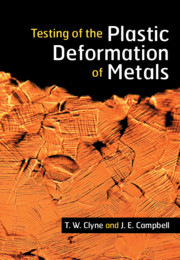Book contents
- Testing of the Plastic Deformation of Metals
- Reviews
- Testing of the Plastic Deformation of Metals
- Copyright page
- Contents
- Preface
- Nomenclature
- 1 General Introduction
- 2 Stresses, Strains and Elasticity
- 3 Continuum Plasticity
- 4 Mechanisms of Plastic Deformation in Metals
- 5 Tensile Testing
- 6 Compressive Testing
- 7 Hardness Testing
- 8 Indentation Plastometry
- 9 Nanoindentation and Micropillar Compression
- 10 Other Testing Geometries and Conditions
- Index
- References
7 - Hardness Testing
Published online by Cambridge University Press: 24 May 2021
- Testing of the Plastic Deformation of Metals
- Reviews
- Testing of the Plastic Deformation of Metals
- Copyright page
- Contents
- Preface
- Nomenclature
- 1 General Introduction
- 2 Stresses, Strains and Elasticity
- 3 Continuum Plasticity
- 4 Mechanisms of Plastic Deformation in Metals
- 5 Tensile Testing
- 6 Compressive Testing
- 7 Hardness Testing
- 8 Indentation Plastometry
- 9 Nanoindentation and Micropillar Compression
- 10 Other Testing Geometries and Conditions
- Index
- References
Summary
Hardness test procedures of various types have been in use for many decades. They are usually quick and easy to carry out, the equipment required is relatively simple and cheap, and there are portable machines that allow in situ measurements to be made on components in service. The volume being tested is relatively small, so it’s possible to map the hardness number across surfaces, exploring local variations, and to obtain values from thin surface layers and coatings. The main problem with hardness is that it’s not a well-defined property. The value obtained during testing of a given sample is different for different types of test, and also for the same test with different conditions. Identical hardness numbers can be obtained from materials exhibiting a wide range of yielding and work hardening characteristics. The reasons for this are well established. There have been many attempts to extract meaningful plasticity parameters, particularly the yield stress, from hardness numbers, but these are mostly based on neglect of work hardening. In practice, materials that exhibit no work hardening at all are rare and indeed quantification of the work hardening behavior of a metal is a central objective of plasticity testing. The status of hardness testing is thus one of being a technique that is convenient and widely used, but the results obtained from it should be regarded as no better than semi-quantitative. There are procedures and protocols in which they are accorded a higher significance than this, but this is an unsound approach.
- Type
- Chapter
- Information
- Testing of the Plastic Deformation of Metals , pp. 123 - 147Publisher: Cambridge University PressPrint publication year: 2021

